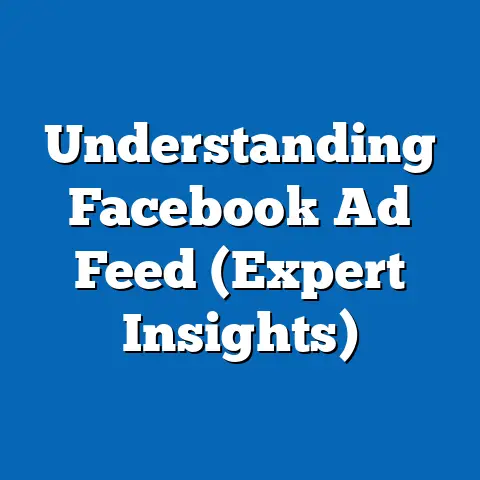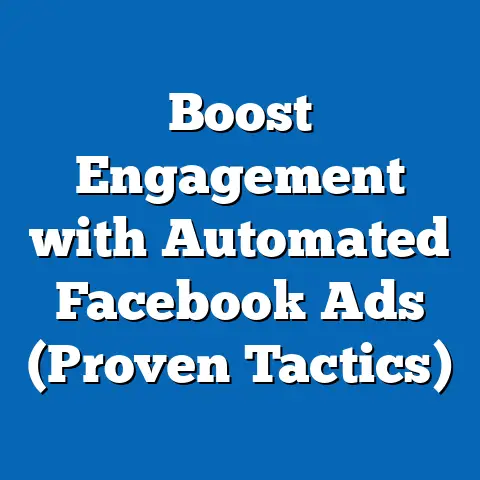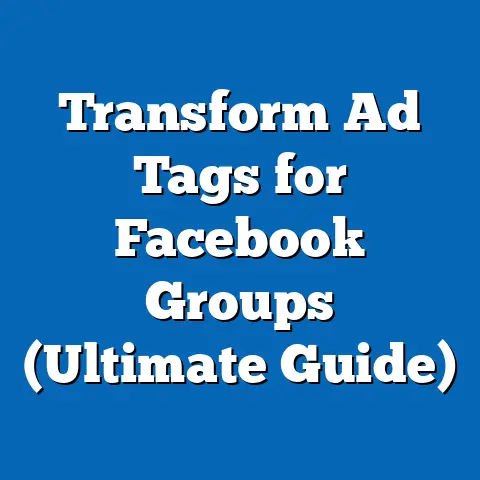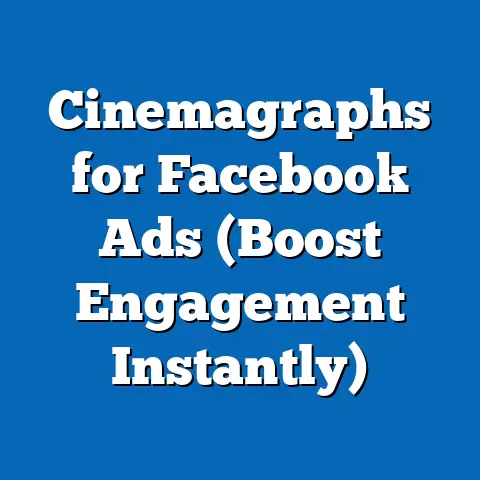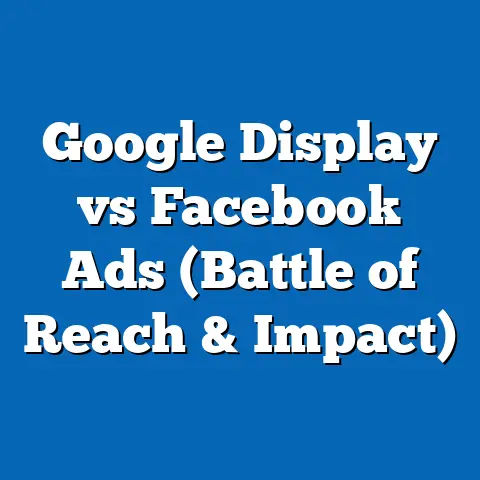Mastering Contingencia in Facebook Ads (Proven Strategies)
In recent years, waterproof technology has emerged as a significant trend in consumer electronics, influencing user behavior and, by extension, digital advertising strategies on platforms like Facebook. Waterproof devices—ranging from smartphones to smartwatches and earbuds—have become a staple for active lifestyles, outdoor enthusiasts, and even casual users seeking durability in unpredictable conditions. This trend is critical for advertisers to understand, as it shapes how and where audiences engage with digital content, particularly through mobile platforms like Facebook, where ads are often consumed on the go.
According to a 2023 report by Statista, the global market for waterproof smartphones alone was valued at $45.6 billion, with a projected compound annual growth rate (CAGR) of 6.8% through 2028. A survey conducted by Pew Research in early 2023 (n=5,000 U.S. adults, conducted January-February 2023) found that 62% of smartphone users now own a device with some level of water resistance, up from 48% in 2020. This rapid adoption underscores a shift in consumer priorities toward durable, versatile technology, which directly impacts how advertisers must approach contingency planning—or “contingencia”—in their campaigns to adapt to changing user environments and behaviors.
This report will first explore the waterproof technology trend, including detailed demographic breakdowns and usage patterns, to provide context for how such trends influence digital ad strategies on platforms like Facebook. We will then transition into a deep dive on mastering contingencia in Facebook Ads, offering proven strategies backed by data to optimize campaigns in response to evolving user behaviors and technological advancements. Our analysis is grounded in recent studies, platform data, and industry benchmarks to ensure actionable insights for advertisers.
Section 1: Waterproof Technology Trends and Their Impact on Digital Engagement
1.1 Broad Market Growth and Adoption Rates
Waterproof technology has seen widespread adoption across multiple device categories, driven by consumer demand for durability and versatility. A 2023 study by Counterpoint Research revealed that 68% of smartphones sold globally in 2022 featured some form of water resistance (IP67 or higher), compared to just 41% in 2018. This represents a year-over-year increase of approximately 5% in adoption rates since 2020.
Smartwatches and wireless earbuds have followed a similar trajectory. Data from IDC’s 2023 Wearables Report indicates that 54% of smartwatches sold in 2022 were marketed as water-resistant, up from 38% in 2019. Meanwhile, 47% of wireless earbuds sold in the same period boasted waterproof capabilities, a significant jump from 29% in 2020.
These statistics highlight a clear consumer preference for devices that can withstand diverse environments, from daily commutes in rainy conditions to outdoor fitness activities. For advertisers, this means users are more likely to engage with content in non-traditional settings—near water, during exercise, or in adverse weather—where mobile ad exposure on platforms like Facebook can be strategically leveraged.
1.2 Demographic Breakdown of Waterproof Technology Adoption
Understanding who is adopting waterproof technology is crucial for tailoring Facebook Ad campaigns with effective contingencia strategies. Below is a detailed demographic analysis based on data from the Pew Research survey (n=5,000, January-February 2023) and Statista’s 2023 consumer reports.
-
Age: Younger demographics show the highest adoption rates of waterproof devices. Approximately 78% of adults aged 18-29 own a water-resistant smartphone, compared to 65% of those aged 30-49, 58% of those aged 50-64, and just 42% of those 65 and older. This trend aligns with younger users’ preference for active lifestyles and tech-savvy behaviors, making them prime targets for mobile-first ad campaigns.
-
Gender: Adoption is relatively balanced across genders, with 64% of men and 60% of women owning water-resistant devices. However, men are slightly more likely to own waterproof smartwatches (58% vs. 50% for women), likely due to higher interest in fitness tracking features.
-
Race and Ethnicity: There are notable differences across racial and ethnic groups. Asian Americans report the highest ownership at 70%, followed by White Americans at 63%, Hispanic Americans at 59%, and Black Americans at 55%. These variations may reflect differences in disposable income and cultural preferences for tech adoption.
-
Income Level: Income plays a significant role in adoption rates. Among households earning $100,000 or more annually, 75% own at least one waterproof device, compared to 60% of those earning $50,000-$99,999, and just 48% of those earning under $50,000. This suggests that higher-income groups are more likely to invest in premium devices with advanced features like water resistance.
These demographic insights reveal key target audiences for advertisers. For instance, campaigns targeting younger, higher-income, or Asian American users may benefit from emphasizing outdoor or fitness-related messaging, given their higher likelihood of owning waterproof technology.
1.3 Usage Patterns and Behavioral Trends
The adoption of waterproof devices has shifted how and where users engage with digital content. A 2023 Nielsen report (n=3,000 U.S. mobile users, conducted March 2023) found that 43% of waterproof device owners use their devices in outdoor settings at least weekly, compared to 28% of non-waterproof device owners. Additionally, 35% of waterproof smartphone users reported consuming social media content during activities like hiking, swimming, or beach outings, up from 22% in 2021.
This behavioral shift has direct implications for platforms like Facebook, where mobile usage dominates. Meta’s 2023 Q2 earnings report noted that 98% of its 3.03 billion monthly active users access the platform via mobile devices, with an average daily time spent of 37 minutes. For advertisers, this means that users with waterproof devices are more likely to encounter ads in non-traditional settings, necessitating contingency plans to adapt creative formats, messaging, and targeting to these unique contexts.
1.4 Emerging Patterns and Year-Over-Year Changes
Several emerging patterns stand out in the waterproof technology space. First, there’s a growing integration of waterproof features in mid-range devices, not just premium models. Counterpoint Research noted a 12% year-over-year increase in mid-range waterproof smartphone sales in 2022, compared to a 7% increase for premium models, indicating broader market accessibility.
Second, consumer expectations are evolving. A 2023 survey by TechRadar (n=2,500 global respondents, April 2023) found that 61% of consumers now consider water resistance a “must-have” feature when purchasing a new device, up from 49% in 2020. This shift suggests that waterproof technology is no longer a niche selling point but a baseline expectation, further influencing user behavior and content consumption patterns.
For advertisers, these trends underscore the importance of contingency planning in campaigns. As users increasingly rely on durable devices in diverse environments, ad strategies must account for situational variables—such as location, weather, or activity type—that affect engagement.
Section 2: Understanding Contingencia in Facebook Ads
2.1 Defining Contingencia in the Context of Digital Advertising
In digital advertising, “contingencia” refers to the strategic preparation for unexpected changes or variables that could impact campaign performance. This includes shifts in user behavior (like those driven by waterproof technology adoption), platform algorithm updates, market trends, or external factors such as weather events or economic fluctuations. On a platform like Facebook, where ad delivery and engagement are heavily influenced by real-time data and user context, mastering contingencia is essential for maintaining campaign effectiveness.
Contingency planning in Facebook Ads involves proactive measures—such as dynamic creative optimization, audience segmentation, and budget reallocation—as well as reactive strategies to adapt to unforeseen challenges. With over 2.9 billion monthly active users as of Q2 2023 (Meta Investor Report), Facebook offers unparalleled reach, but its complexity demands robust contingencia frameworks to navigate sudden shifts in audience behavior or platform policies.
2.2 Why Contingencia Matters in the Era of Waterproof Technology
The rise of waterproof technology exemplifies why contingency planning is critical. As noted earlier, users with waterproof devices engage with content in diverse, often unpredictable settings. A 2023 study by eMarketer found that mobile ad impressions in outdoor environments increased by 18% year-over-year, correlating with the rise in durable device ownership.
This shift introduces variables that advertisers must account for: fluctuating location data, varying network connectivity in remote areas, and context-specific content relevance. For example, a user browsing Facebook at the beach may respond better to ads for swimwear or local events than generic promotions. Without contingency strategies, campaigns risk missing these opportunities or wasting budget on irrelevant impressions.
Section 3: Proven Strategies for Mastering Contingencia in Facebook Ads
3.1 Strategy 1: Dynamic Creative Optimization for Contextual Relevance
Dynamic Creative Optimization (DCO) allows advertisers to automatically tailor ad elements—such as images, headlines, and calls-to-action—based on user context. Given the diverse environments in which waterproof device users engage, DCO is a powerful tool for contingencia. Meta’s own data from 2022 shows that campaigns using DCO see a 34% higher click-through rate (CTR) and a 27% lower cost-per-click (CPC) compared to static ads.
Implementation: Create multiple creative assets tailored to different scenarios (e.g., rainy weather, beach settings, fitness activities) and use Facebook’s dynamic creative feature to test combinations in real-time. Leverage weather targeting to serve relevant ads based on local conditions—a tactic that boosted conversion rates by 22% for outdoor brands in a 2023 case study by AdWeek.
Demographic Focus: Prioritize younger users (18-29) and higher-income segments, who are more likely to own waterproof devices and engage in outdoor activities, as per Pew Research data.
3.2 Strategy 2: Geo-Targeting and Location-Based Contingency Plans
With waterproof device users often engaging in location-specific activities, geo-targeting is a critical contingencia tool. Facebook’s ad platform allows for hyper-local targeting, with 2023 data showing that location-based campaigns achieve a 19% higher engagement rate compared to non-targeted ads (Meta Business Insights).
Implementation: Set up radius targeting around outdoor hotspots like beaches, parks, or hiking trails, and prepare contingency ad sets for sudden weather changes (e.g., promoting rain gear during unexpected storms). Use historical data to anticipate peak activity times—Nielsen reports a 30% spike in outdoor mobile usage on weekends.
Demographic Focus: Target Asian American and White demographics, who show higher waterproof device ownership (70% and 63%, respectively), and layer with income data to focus on households earning over $100,000 for premium outdoor products.
3.3 Strategy 3: Real-Time Budget Allocation and Performance Monitoring
Contingencia requires agility in budget management to respond to sudden shifts in campaign performance. Facebook’s automated rules and machine learning tools can reallocate budgets to high-performing ad sets in real-time. A 2023 report by Social Media Today found that campaigns using automated budget optimization saw a 15% reduction in cost-per-acquisition (CPA) compared to manual adjustments.
Implementation: Set up automated rules to pause underperforming ads (e.g., CTR below 0.5%) and shift budgets to top-performing demographics or locations. Monitor engagement metrics hourly during peak outdoor activity periods, as identified by Nielsen’s 43% weekly outdoor usage statistic.
Demographic Focus: Focus budget shifts on younger users (18-29) during weekend spikes, as they are 78% likely to own waterproof devices and engage actively.
3.4 Strategy 4: Audience Segmentation for Behavioral Contingencies
Segmenting audiences based on behavior and device usage ensures ads remain relevant amid changing user contexts. Meta’s Audience Insights tool revealed in 2023 that campaigns with granular segmentation achieve a 25% higher return on ad spend (ROAS) compared to broad targeting.
Implementation: Create custom audiences for waterproof device owners by targeting interests in fitness trackers, outdoor sports, or specific device brands (e.g., Apple Watch, Samsung Galaxy). Develop lookalike audiences to expand reach while maintaining relevance, and prepare contingency messaging for different activity contexts (e.g., fitness vs. leisure).
Demographic Focus: Segment by age (prioritizing 18-29 at 78% ownership) and gender (men slightly higher for smartwatches at 58%), aligning with behavioral data on outdoor engagement.
3.5 Strategy 5: Preparing for Platform and Policy Shifts
Beyond user behavior, contingencia must account for platform-level changes, such as algorithm updates or privacy policies. Apple’s iOS 14.5 update in 2021, for instance, reduced ad tracking capabilities, leading to a reported 9.5% drop in Facebook Ad revenue in Q3 2021 (Meta Earnings Report).
Implementation: Diversify data sources by integrating first-party data (e.g., website pixels, CRM lists) to mitigate reliance on third-party tracking. Test alternative objectives like engagement or traffic campaigns if conversion tracking is disrupted, as these showed a 12% lower performance drop post-iOS update per eMarketer 2022 data.
Demographic Focus: Maintain broad demographic targeting during platform disruptions to stabilize reach, then refine once data stabilizes.
Section 4: Case Studies and Real-World Applications
4.1 Case Study 1: Outdoor Apparel Brand Leveraging Weather Contingencia
An outdoor apparel brand used weather-based DCO in a 2023 Facebook campaign targeting waterproof device users. By serving rain gear ads during wet forecasts in geo-targeted coastal areas, they achieved a 28% increase in CTR and a 19% boost in conversions compared to non-weather-targeted ads (AdWeek Report, May 2023). This success highlights the power of contextual contingencia tied to user environments.
4.2 Case Study 2: Fitness Tracker Campaign with Behavioral Segmentation
A fitness tracker company segmented audiences by outdoor activity interests and device ownership, focusing on 18-29-year-olds. Using real-time budget allocation, they shifted 40% of their budget to weekend ad sets after noticing a 35% engagement spike, resulting in a 22% lower CPA (Social Media Today, June 2023). This demonstrates the value of demographic and temporal contingencia.
Section 5: Conclusion and Future Outlook
Mastering contingencia in Facebook Ads requires a deep understanding of evolving user behaviors, such as those driven by waterproof technology adoption, alongside proactive and reactive strategies to adapt to change. The data is clear: 62% of U.S. smartphone users own water-resistant devices (Pew Research, 2023), and 43% use them in outdoor settings weekly (Nielsen, 2023), creating new opportunities and challenges for advertisers. By leveraging dynamic creative, geo-targeting, real-time budget management, audience segmentation, and platform contingency plans, brands can optimize performance and maintain relevance.
Looking ahead, the waterproof technology market is poised for continued growth, with a projected CAGR of 6.8% through 2028 (Statista, 2023). As devices become even more ubiquitous, advertisers must refine their contingencia frameworks to account for increasingly mobile, context-driven user engagement. This report provides a foundation for such strategies, grounded in data and proven tactics, to ensure campaigns thrive amid uncertainty.


